|
1.
CENTRAL/ WEST AFRICA
Markets flat
Markets remain flat and prices for both logs and lumber
are unchanged this mid-month. The demand also remains
in the same pattern that has developed over the past
months. Broadly, Asian destinations are moderately busy.
Log demand in China and India is firm and prices are
steady. Demand from continental European buyers is
either very slow or in the case of southern Europe virtually
at a standstill.
Collapse in Spanish demand
Spain and Portugal are very quiet due to the building and
construction downturn in Spain in particular and suppliers
say it is unlikely to recover for possibly several years. This
collapse in demand has seriously affected those West
African log exporters that relied on Spanish purchases of
the lower and more mixed qualities.
Finding new markets has not been easy, however there are
reports of some recent success in penetrating Middle East
markets where there is some demand for logs and even
more demand for sawn lumber. This demand is said to be
attracting some business that was previously almost
wholly taken up by Asian suppliers of meranti and other
mixed light red hardwoods.
Costs rise
The rain season is affecting operations in Gabon and
leading to transport problems thus increasing the cost of
moving logs and lumber over the long distances to the
port. Exports of sawn lumber to Europe are so low that
producers report difficulty and delays in finding freight as
fewer ships are now making regular calls.
In Cameroon the seasonal rains continue but are expected
to ease at the end of November, however given the state of
the European market there will be little incentive for mills
to expand sawmill output.
Azobe over-production
Reports are emerging suggesting that the Cameroon
production of azobe lumber is well above the current
demand and stocks are climbing.
As previously reported, the relationship between lumber
output and the current demand appears to be finely
balanced and some West African producers believe that
care is needed to avoid overproduction and price
weaknesses in the more popular species. A salutary
example is sapele lumber where prices are still weak after
many months even though the excess stocks have long
been bought.
Okoume logs and lumber shipments and prices are holding
very firm on the strong demand.
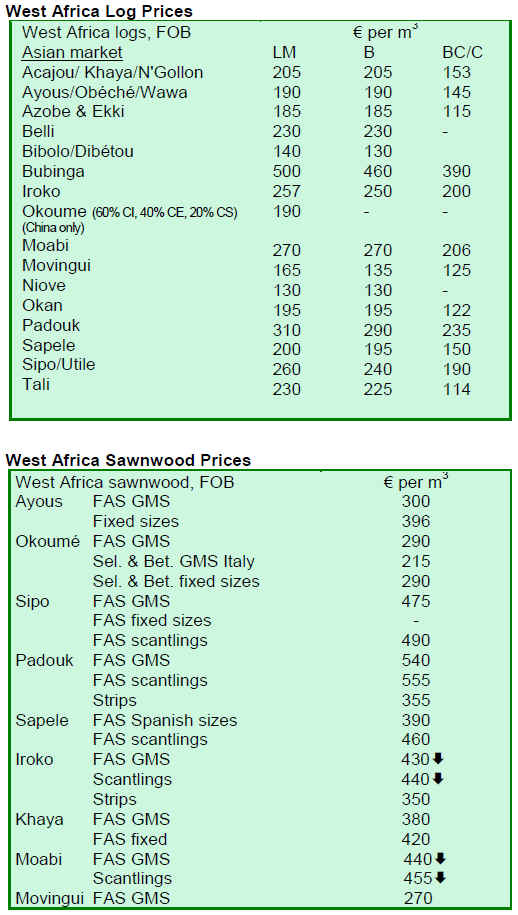
2. GHANA
Oil exports to drive 2010 growth
The Ghanaian economy remains steady but is being
impacted by deteriorating fiscal and external balances
because of the global economy. Real GDP growth was
around 6.4 per cent in 2008, slightly exceeding the 5.7 per
cent average in 2000-07.
Growth is projected to dip in 2009 as export performance
weakens on account of the global economic crisis, but then
to pick up again in 2010 as Ghana begins to export crude
oil.
Forest plantation plan
To restore the dwindling forest cover of the country, the
government has announced a National Forest Plantation
Development Programme. According to the Minister of
Lands and Natural Resources, Alhaji Dauda, Cabinet has
already given its approval for the programme which could
generate about 30,000 jobs to contribute to a reduction in
rural poverty.
The immediate objective of the programme is to increase
the tree cover in the country. The programme is also
intended to improve environmental quality, reduce the
wood deficit and provide an avenue for the country to tap
the emerging benefits from climate change markets for
carbon and sequestration projects.
The Minister reportedly said the long term goal of the
plantation development initiative was to develop a
sustainable forest resource base that would satisfy future
demands for industrial timber and enhance environmental
quality, thereby reducing pressure on existing natural
forests.
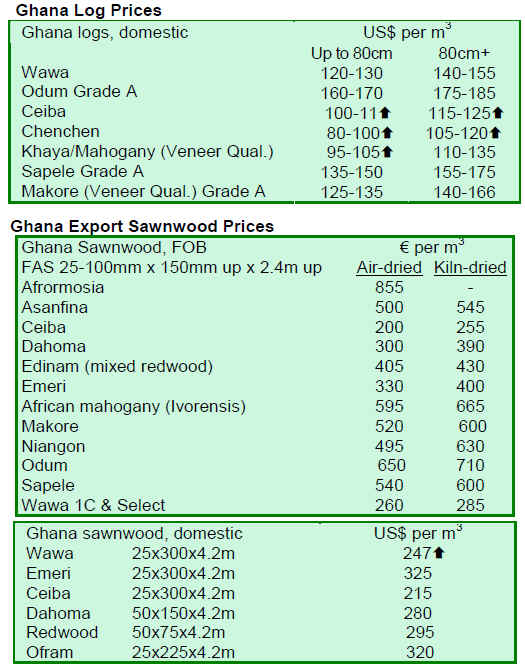
3.
MALAYSIA
Optimism returns
The year end monsoon season failed to lift prices of timber
products higher as usually happens and this was because
millers are holding above normal stocks of sawnwood and
panel-products. However, timber traders are growing more
optimistic as the year comes to an end with positive
economic and business news emerging on the US, EU and
Japanese economies.
Former US Federal Reserve Chairman Alan Greenspan
mentioned recently that a rebound in US stocks is ¡°reliquefying¡±
the US economy and there are indications that
the decline in the house prices has bottomed out.)
MIFF 2010
Malaysian furniture manufacturers are optimistic that the
US economy has bottomed out and are expecting that US
buyers will be in the market soon. Manufacturers expect
the first signs of a turn-around to be in orders generated by
the annual Malaysia International Furniture Fair (MIFF)
2010 to be held from March 2 - 6, 2010.
MIFF 2010 will be held at three locations, the Putra World
Trade Centre, the Kuala Lumpur Convention Centre and
the MATRADE Exhibition and Convention Centre. A
separate event entitled ID Trend will be held by the
organizers of MIFF 2010 for local. The organizers are
targeting more than 20,000 visitors this year.
Japan¡¯s growth good for panels
The current-account surplus of Japan, the world¡¯s second
largest economy grew wider in September as worldwide
government stimulus spending helped to mitigate declines
in exports.
This has given Malaysian panel products manufacturers a
measure of optimism that the construction industry in
Japan will begin to pick by early spring 2010. However,
the panel products industry is wary that the price increase
of crude oil towards US$80 per barrel may unhinge
business sentiment. China has already increased fuel
prices in the wake of the increase.
The price increase of crude oil will also affect prices of
palm oil, which analysts suggest could rise above RM2,
600 per tonne by April next year if palm oil stocks remain
tight and the crude oil price remains above US$75 per
barrel. This would cause the prices of oil palm fibres, a
source of raw material for many panel-products, to
increase.
China¡¯s property market
House prices in China are rising and the latest monthly
increase of around 4% is the biggest gain in the last 14
months.
This price increase underlines the recovery in the Chinese
property market and the Chinese construction industry.
This is good news for exporters and the Malaysian timber
industry is preparing for a wave of buying of raw materials
by China. This would be important as purchases by
Middle-Eastern buyers begin to slow.
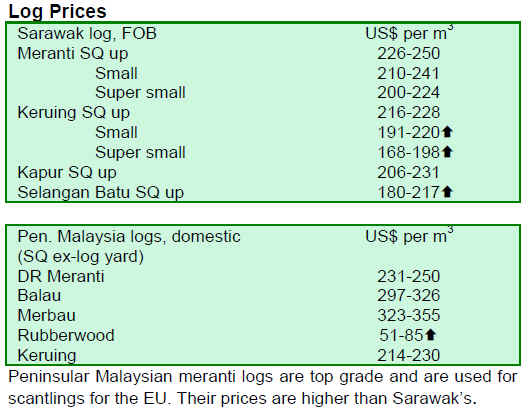
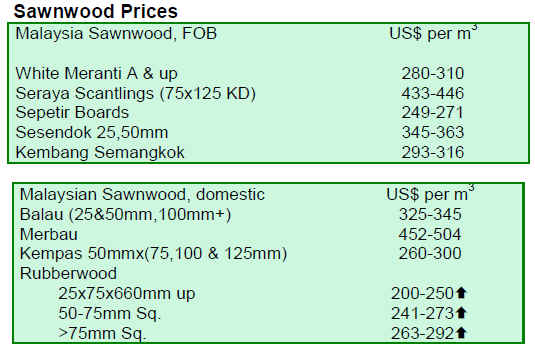
4.
INDONESIA
Indonesia furniture fair
Indonesia will be holding its third International Furniture
and Craft Fair (IFFINA 2010) in Jakarta, March 11 - 14,
2010. It will be held at the Jakarta International Expo
(JIExpo) Kemayoran Centre. The event will be hosted by
ASMINDO and is supported by various Indonesian
government departments and trade bodies.
The organizers of IFFINA 2010 have confirmed 350
exhibitors to date and are targeting at least 10,000
international visitors and buyers.
Stimulus package delay
In a statement that could help to further stabilise prices of
Indonesian timber products and other building materials
the Indonesian finance minister said the government could
intends to spend about 60% of this year¡¯s stimulus
financing on infrastructure-related projects. Over the past
nine months only some 42% of the money available had
been spent.
The Indonesian government had allocated approximately
US$1.2 billion for infrastructure construction purposes.
This was to cover projects on seaports, airports, toll roads
and bridges and other vital infrastructure. In the absence of
rapid government spending it has been domestic spending
that has accounted for much of the growth particularly in
the retail sector.
Action on Forest fires
At the recent ASEAN environment ministers meeting held
in Singapore, Indonesia announced that it will implement
measures that are aimed at reducing the incidences of
forest fires, an annual problem that leads to serious air
pollution in the country and in the region.
The minister added that his is part of Indonesia¡¯s promise
to cut quarter of its total greenhouse-gas emissions by
2020. Although, Indonesia had not yet signed the 2002
ASEAN Agreement on Trans-boundary Haze Pollution, it
seems that this would eventually be done.
In addition, Indonesia and Australia have launched a forest
fire detecting system called Indofire - Indowatch. This will
utilise satellite images that will detect and inform
authorities about forest fires in both countries on a realtime
basis.
This support is apparently part of Australia's AU$40
million assistance programme for Indonesia in dealing
with carbon and forest issues.
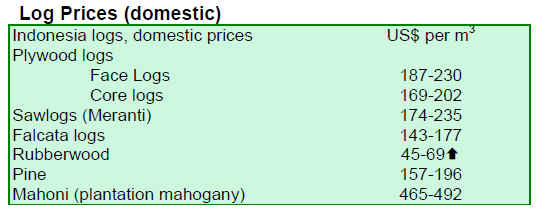
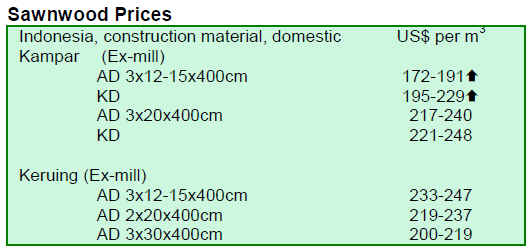
5.
MYANMAR
Indian demand
Exporters in Myanmar report that the Indian market can
absorb a wide range of grade of teak logs, even the lower
grades for its local consumption as well as for export. At
present, say local analysts, it is only the India market that
is active for teak.
The trade is saying that that a full recovery in the teak
market could be expected by mid-2010, but this is a very
difficult situation to assess and predict. Teak used to be the
darling export commodity for Myanmar during the past
decade, but this is no longer so.
Other than teak
Hardwood logs notably Pyinkado are still actively
purchased by buyers in Vietnam and India, but current
purchases are low compared to previous years. Gurjan logs
are also shipped out in considerably quantities. It could be
said that the trade of hardwood logs (that is other than
teak) is quite active compared to the trade levels in logs in
other exporting countries.
There is talk that MTE (Myanmar Timber Enterprise) may
scale down the extraction of teak in the coming year. It
appears that more emphasis is now given to the
reforestation, especially the establishment of plantations.
Statistical update
The following table shows the shipment data from April
2009 to October 2009. Indications are that shipments of
logs are on the rise. Other hardwood shipments peaked in
July and August and declined slightly in September and
October. The shipment of rough-sawn timber, and other
processed wood products are, by contrast, not very
promising.
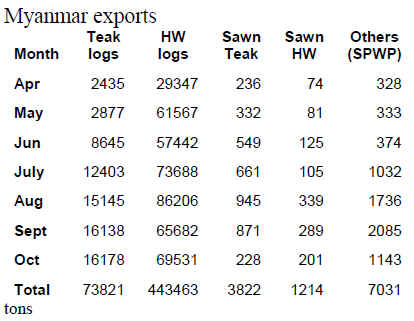
Mangroves
The domestic press in Myanmar is reporting that
according to a FREDA official, a network of 17 local
NGO¡¯s has been formed to implement the replanting of
existing tidal forests in the country. FREDA (Forest
Resources & Environment Development Association) is a
local NGO formed by retired senior foresters and forestry
experts. The project will apparently extend along a 2500
km stretch of coastline starting from the Naaf River in the
Rakhine State in the west of Myanmar, to the Myeik
(Mergui) Archipelago in the south-east.
The project will begin with an initial funding of
US$500,000. Mangrove plantations will be established in
the Ayeyarwady delta that was hit by the Nargis Cyclone
in May 2008, as first priority.
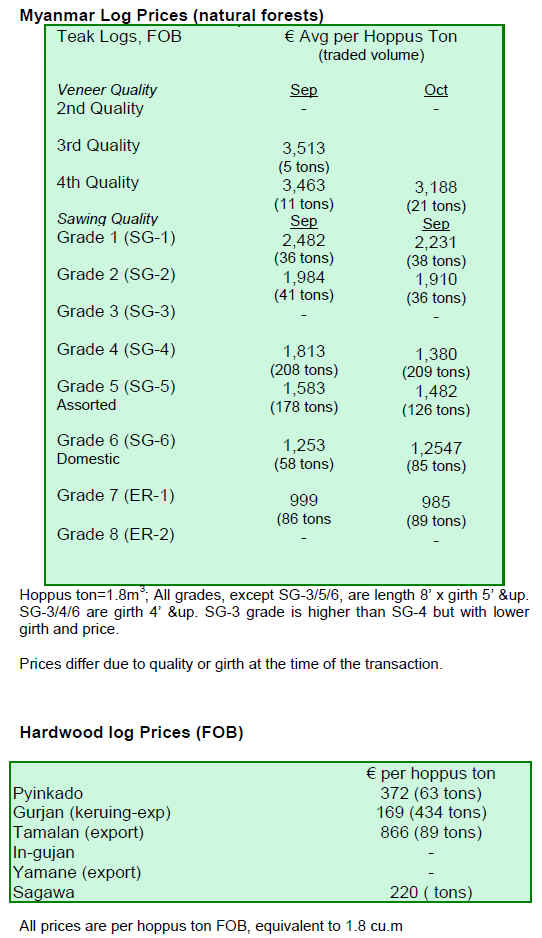
6. INDIA
Markets active
Post monsoon activity in the timber market is brisk.
Government Forest Depot auctions are on and remnant of
last seasons¡¯ logs have been sold. New arrivals are
reported as substantial with over 15,000 cu.m of teak logs
coming from the Vyara and Dang Divisions of Western
India and the Betul Division of Central India. All have
been sold at good rates.
The quality of this year¡¯s cut has been generally good and
being the first auction of the new harvesting season,
buyers were quite enthusiastic. Compared to last season,
these auctions saw prices going higher by around 10-15%
over previous levels.
Domestic purchases
Hardwood imports are also in full swing but currently the
trade prefers to try and snap up local forest grown Teak
logs hence higher prices. Current prices per cubic foot
Hoppus are shown below
Teak A+ Shipbuilding quality
Rs.1800 to 2000
Teak B+ Shipbuilding
Rs.1700 to 1800
Teak A+ Sawing quality logs
Rs.1500 to 1600
Teak B+ Sawing quality logs
Rs.1400 to 1500
Teak long length medium girth Rs.1200 to 1300
Teak long length small girth logs Rs.1100 to 1200
Teak sawing quality C+
Rs.950 to 1100
Amongst non-teak species on offer Adina cordifolia,
(known as Kadam or Kadamba) and Terminalia tomentosa
(Indian Laurel) fetched around Rs.350 for A grade, around
Rs.250 for B grade and around Rs.150 for C grade logs per
c.ft Hoppus.
Mills at full capacity
With Diwali (festival of lights) holidays coming to an end,
workers have returned from home towns and the mills
which were suffering due to a labour shortage are once
again running at full swing.
Of late, imports of sawnwood have been increasing as the
difference in import duties for logs and sawn timber has
narrowed also exporting countries are offering sawn
timber at good prices. Sawnwood importers are happy but
saw mills which were processing imported logs are
worried at this development as they see growing
competition from sawnwood imports.
On the financial front, corporate results for the half year
ending 30th September are showing good results and this
has lifted confidence all around. Added to that, reports of
improvement in the US and Europe economies has driven
fresh activity in the wood product export sector.
India¡¯s overall exports are still under pressure showing a
decline of 14% for September, but the wood products
sector has seen no downturn and the Indian Export
Promotion Council is optimistic that last years¡¯ levels will
be maintained and probably exceeded.
Teak prices
The flow of imported Teak and other hardwood logs is
satisfactory. Exports of wood products have been rising.
Teak supplies from Myanmar seem to be dropping and the
quality is slipping. Presently plantation shipments arriving
from Benin and Ghana are better and fill in for the
shortages from Myanmar.
The current prices for Teak imported from various sources
other than Myanmar are shown below. All rates are per
cubic meter C&F Indian ports.
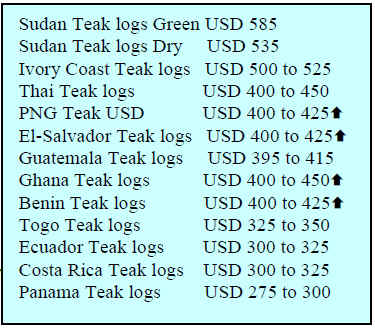
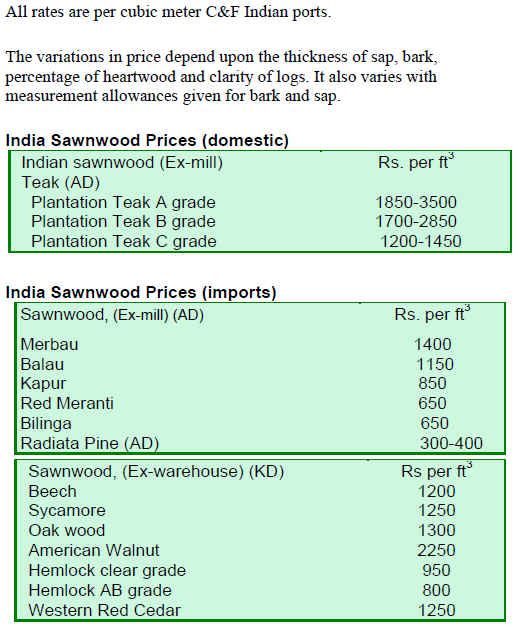
7. BRAZIL
Trade in Mato Grosso
Over the past 3 years the logging sector in Mato Grosso in
the Amazon region has generated business worth some
BRL 5.9 billion. Of this, the largest sales (BRL 3.5 billion)
have been of products destined for the domestic market in
other states. Companies in Sinop sold nearly 15% of all
volume traded in Mato Grosso. Business transactions
reached BRL 877.8 million, of which BRL 516.7 million
was sold to customers in other states; BRL 256.8 million
to the international market, and BRL 104.4 million to
customers within the state.
Aripuanã, on the other hand sold only 9% of the total state
sales (BRL 532.3 million0 locally, the largest share was to
international market
Advanced logging software
To assist companies with improvements to timber resource
management researchers from the Federal Rural
University of Amazonia and the Par¨¢ administration are
reportedly developing software for logging management.
In outline this new software allows cost saving planning,
implementation and monitoring of forest management
activity, providing lower costs to producer and less impact
to the environment. Initial training has been undertaken for
professionals working with timber companies and others.
This new system is expected to be implemented in all
Amazonian states by late 2010.
The advantage of the system say analysts is the scope of
information generated and that the digital model helps the
enforcement of forest management plans. The mapping
and field operations tracking make logging activities more
transparent and facilitate careful monitoring say the
developers
Difficult times for the trade
At the recently concluded International Timber Trade
Federation Day (Oct 2009, Geneva) Marco Tuoto of STCP
Brazil, discussed the challenges facing the Brazilian
timber sector.
This outlined Brazil¡¯s resource base, trends in production
and trade and issues of legality verification and the
implications for the Brazilian timber sector. The
presentation identified the global and domestic factors
responsible for the declining exports of which the
appreciation of the Brazilian currency against the US
dollar and falling consumption in the main markets.
Furniture sector closures
Furniture manufacturers in Santa Catarina have been
reducing their labour force as exports have plummeted
because of falling demand in export markets and because
of the appreciation of the Brazilian Real.
Many companies have been reducing the payroll and some
mills have decided to close until the markets pick up.
Reports indicate that there was around a 30% cut in the
work force in the furniture industries in the region.
Analysts point out that the raw materials and even
machinery are Brazilian-made and costs in dollar terms
have been rising sharply. In addition the industry is labour
intensive so job losses are high.
One of the greatest difficulties faced by exporters is that of
pricing forward sales when the currency is appreciating so
fast. In many cases over the past year exporters have had
to absorb the losses from exchange rate fluctuations as
contract prices could not be increased with the overseas
buyers.
Action on Argentina import rules
On November 1st Brazil¡¯s Minister of Development
Industry and Trade, reportedly confirmed that the
government is applying ¡®non automatic¡¯ license
requirements for some imports from Argentina. These
measures are similar to those measures adopted by
Argentina some twelve months ago.
This move will inevitably mean that Argentine import
documents will take longer to process and this is likely to
cause delays for goods waiting to cross into Brazil from
Argentina. Argentina imposed similar measures a year ago
and this has resulted in a slowing of trade between the two
countries.
It is not certain at the moment what range of products will
be included in the latest move by the Brazilian
government. This matter now needs mediation and
observers say it could be that either the WTO or Mercosur
will become involved.
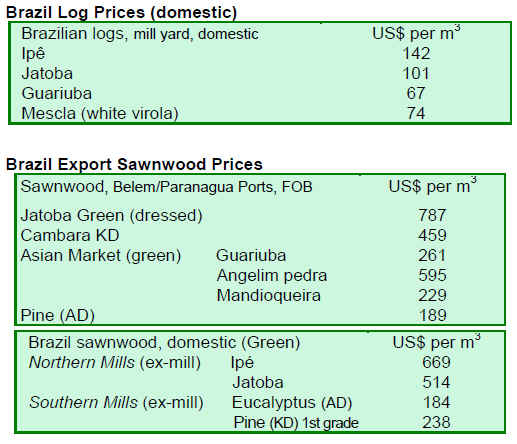
8.
PERU
Asian markets strongest
The market situation remains very quiet with only the
Asian market showing signs of recovery. Demand from
Asian buyers while not considered strong, has been
healthy enough in recent weeks to lift prices of some
products.
Loans up
Peru's private sector banks saw a rise in consumer,
mortgage and micro-enterprise loans in September, but a
drop in their biggest segment, commercial loans.
Competitiveness support
The World Bank has approved a US$150 mil. loan for
Peru to lift its fiscal management and competitiveness.
This is part of its commitment to help Peru during the
post-financial crisis period.
This financial tool was arranged in collaboration with the
Government of Peru to help it deal with the short-term
effects of the global financial crisis.
Towards FTA
Peru's Government has apparently ratified the ¡°Agreement
signed between the Republic of Peru and Japan for the
Promotion, Protection and Liberalization of Investment¡±.
This ratification is just one more step as a prerequisite for
both countries to start negotiating a Free Trade
Agreement.
San Martin deforestation
The Regional Director of Agriculture has said a third of
San Martin forests have been degraded by shifting
agriculture. He estimated of the 5 mil hectares of forest in
San Martin some 1 mil. hectares has been lost or degraded.
Disney investment in forests
Walt Disney Co. has a forest conservation programme
which will deliver some US$7 mil. this year to forest
conservation. Some US$1 million will reportedly be
provided to the Alto Mayo Protection Forest in the
department of San Martin, northern Peru.
The Alto Mayo project covers an area of about 300,000
hectares and is managed by local communities, local
organizations, including the Peruvian Environmental Law
Society, SPDA, the Andean Ecosystems Association, the
Ministry of the Environment and the national parks service
as well as Conservation International.
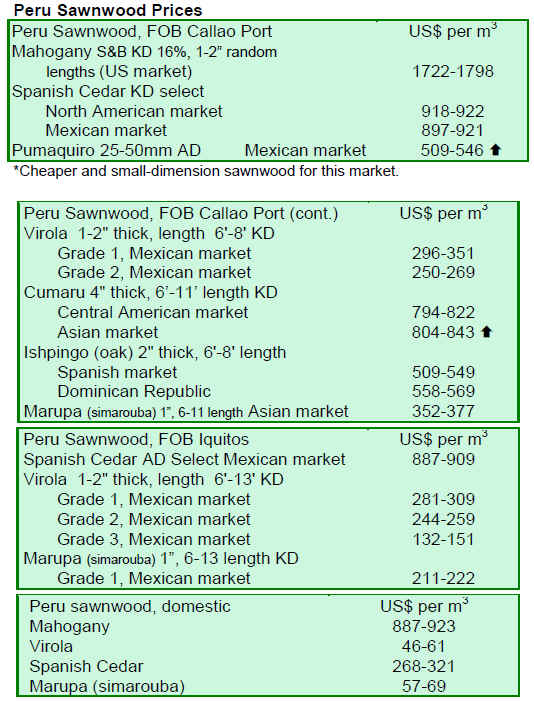
9. BOLIVIA

10. MEXICO
CONAFOR strategies
In the last Forest Expo, the National Forest Agency
(CONAFOR) announced changes in its programmes and
these included details of a new approach to ProTree, its
programme to achieve sustainable forest development in
the country.
As part of the seventh Forest Expo held in Mexico City
federal official discussed the ongoing diagnosis of the
institution and its programmes to support the forestry
sector. The first objective is to improve the allocation of
resources taking account of the needs for conservation and
production.
An effort will also be made to create incentives for further
forest conservation or restoration activities. Priority will
be given to the long-term sustainability, enhancing the
legal enforcement, maintenance and monitoring of
reforested areas. The director of CONAFOR said better
coordination between institutions will be achieved to
improve the efficiency of all forestry programs.
Energy from biomass
Mexican authorities, with partners from Canada will
undertake a study on wood waste to generate energy,
CONAFOR will coordinate the work together with the
Technological Institute of El Salto, Pueblo Nuevo, which
will be responsible for execution in the rural areas of
Victoria, Pueblo Nuevo and Durango.
This project aims to determine the amount of energy that
could be produced from biomass in the region and the
quantification of the potential for carbon credits and the
replacement of fuel fossils for power generation.
11.
Guyana
Market Trends
Prices for wood products from Guyana remain generally
stable. However Purpleheart standard sawmill quality logs
recorded a drop in price whilst Purpleheart fair sawmill
quality and Mora standard sawmill quality recorded price
increases of USD$5 per cu.m.
For the period under review prices for ¡®undressed¡¯ (rough
sawn) Greenheart recorded decreases in prices, while
Purpleheart sawnwood prices increased.
Dressed Greenheart also enjoyed significant prices
increases as did dressed purpleheart.

Splitwood, Roundwood (Piles, Poles and Posts) saw
positive price advances adding to the contribution to the
export earnings in this period. Prices were above average
in the period under review.
The contribution to export earnings from trade in value
added products continues to grow. Special mention should
be made on the export of doors which achieved higher
than average prices. Other products including mouldings,
outdoor and indoor furniture, spindles and windows all
contributed well to the export performance of the timber
sector.
Preserve the forest deal
Guyana has a US$250 mil. five-year forest preservation
agreement with Norway, the MOU was signed on 9
October and will begin with the Norwegian government
contributing US$30 mil. in 2010 and potentially up to
US$250 mil. by 2015.
Under the agreement, Guyana will speed its efforts to limit
forest-based greenhouse gas emissions and protect its
rainforest. Norway will provide financial support to
Guyana at a level based on this country¡¯s success in
limiting emissions. This will enable Guyana to start
implementing its Low Carbon Development Strategy
(LCDS).
As the monitoring, reporting and verification (MRV)
system for the forest is developed, and as more accurate
assessments of the carbon stock are determined more
financial support will flow.
There are a number of conditions which Guyana will have
to fulfill to ensure continued support from Norway. These
include maintaining transparent and accountable
processes. Norway has similar programmes of support
with Brazil and Indonesia.
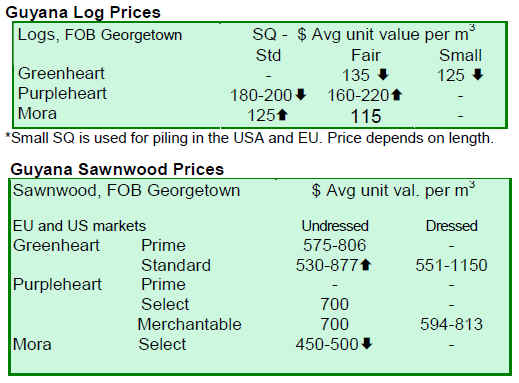
|